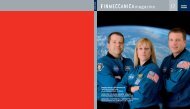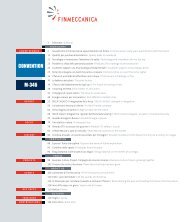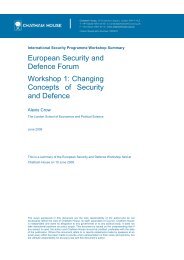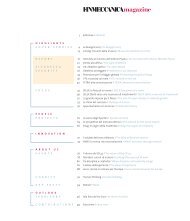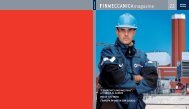E - Finmeccanica
E - Finmeccanica
E - Finmeccanica
You also want an ePaper? Increase the reach of your titles
YUMPU automatically turns print PDFs into web optimized ePapers that Google loves.
D E F E N C E S Y S T E M S<br />
9/2010 FINMECCANICA MAGAZINE<br />
MBDA<br />
THE FUTURE<br />
AS A<br />
STRATEGY<br />
Taking partnership into the<br />
halls of learning<br />
NEW SYSTEMS, EMERGING TECHNOLOGIES, INVESTMENTS,<br />
PARTNERSHIPS WITH UNIVERSITIES: MORE THAN EVER, RE-<br />
SEARCH AND DEVELOPMENT ARE PLAYING A KEY ROLE IN THE<br />
EVOLUTION OF MBDA’S BUSINESS<br />
MBDA’s Internal Research And<br />
Development (IRAD) organisation<br />
plays a key role in developing<br />
the products and technologies that<br />
represent the company’s future, experimenting<br />
with new assemblies and subsystems,<br />
focusing on generating functional<br />
capabilities and emerging technologies<br />
and identifying priorities for<br />
new investment through a continuous<br />
decision-making process based on the<br />
market inputs summarised in the company’s<br />
Integrated Strategic Business Plan<br />
(ISBP). The international team, which<br />
draws its members from France, Italy,<br />
Germany and the UK and is headed up by<br />
Marcello Pacifici, Group Director Engineering<br />
& Seekers and Deputy Executive<br />
Group Director Technical, works within<br />
an integrated organisational structure,<br />
ensuring that projects are subject to<br />
strict technical and financial governance,<br />
and that performance is measured using<br />
regular analyses. The Product Evolution<br />
and Technology Plan (PEATP) is updated<br />
each year, and gathers together investment<br />
proposals from the Product Strategy,<br />
the ISBP and the operating lines to<br />
improve capabilities and acquire or develop<br />
technologies using a combined<br />
top-down and bottom-up approach.<br />
Once it has been agreed, the PEATP is implemented<br />
through the Strategic Technology<br />
Programmes (STPs), which are<br />
used for long-term planning of projects<br />
with the aim of increasing system knowledge<br />
by enhancing the company's ability<br />
to develop specific products, develop prototype<br />
assemblies and sub-assemblies,<br />
acquire the necessary technology for the<br />
development of demonstrators and prototypes<br />
and support risk-reduction programmes.<br />
A full development cycle normally<br />
takes between three and six years,<br />
so assessments covering a period of up<br />
to ten years need to be carried out when<br />
putting in place a strategy for technology<br />
investment. The IRAD R&D budget is allocated<br />
on the basis of a model correlated<br />
to the Technology Readiness Level (TRL),<br />
which is a tool for measuring the maturity<br />
and availability of technologies, in order<br />
to encourage the development of<br />
new products through short- and medium-term<br />
programmes. In 2009, a number<br />
of important programmes were put<br />
in place using the technology plan, including<br />
Ballistic Missile Defence,<br />
SHORAD air defence, the MPCV (Multi-<br />
Purpose Combat Vehicle) platform, highly<br />
mobile armoured vehicles equipped<br />
with Mistral missiles for classic<br />
VSHORAD missions, the CAMM (Common<br />
Anti-air Modular Munition) missile<br />
co-funded by the UK Ministry of Defence,<br />
and MARTE, an anti-ship missile with a<br />
number of different configurations. Particular<br />
attention was paid to certain key<br />
sub-systems and technologies, such as<br />
SEEKAM (a millimetre-wave radar seeker),<br />
co-funded by the Italian Secretariat<br />
General of Defence/National Armaments<br />
Directorate (Segredifesa), Datalink<br />
systems, the IR sensor for the Scalp Naval<br />
anti-ship missile, millimetre-wave phased<br />
array antennas and new nanostructured<br />
ceramic materials for hypersonic missile<br />
radomes. In its technology research programmes,<br />
MBDA collaborates closely<br />
with its shareholders, <strong>Finmeccanica</strong>,<br />
EADS and BEA Systems, with which it has<br />
signed co-operation agreements. Its involvement<br />
in MindSh@re in particular<br />
has helped to foster far-reaching technical<br />
co-operation with other <strong>Finmeccanica</strong><br />
companies. There is also an ever<br />
greater need to involve major European<br />
universities (see box), due to the strong<br />
trend towards state-of-the-art programmes.<br />
All of these crucial initiatives<br />
to tackle future challenges have enabled<br />
MBDA, in its ongoing engagement with<br />
the scientific world, to establish and develop<br />
a network of highly knowledgeable<br />
technical experts whose experience<br />
bridges a range of technological fields.<br />
Through its investments, the IRAD organisation<br />
has helped MBDA to win major<br />
development and production contracts<br />
while minimising technological risks.<br />
Internal Research<br />
& Development Funding<br />
detect<br />
understand<br />
apply<br />
The best Italian universities, including those in<br />
Milan, Genoa, Pisa, Florence, Rome, Cassino,<br />
Naples and many more besides, have signed a<br />
technical and scientific co-operation agreement<br />
with MBDA. In France, the company works with<br />
centres of research and universities such as ISL<br />
(Institut Saint-Louis), ONERA (the French<br />
Aerospace Lab), IRSEEM (Institut de Recherche en<br />
Systèmes Electroniques Embarqués), UTBM<br />
(Université Technologique de Belfort<br />
Montbéliard), INERIS (Institut National de<br />
l’Environnement Industriel et des Risques), CSTL<br />
(Coopération Scientifique et Technologique pour<br />
la Lorraine), the National Physics Laboratory and<br />
Université de Bourgogne. In the UK, partnerships<br />
have been established with the universities of<br />
Cranfield, Lancaster, Manchester, London,<br />
Nottingham and Cambridge.<br />
validate<br />
10% IRAD 40% IRAD 50% IRAD<br />
LONG TERM<br />
Radical concepts<br />
Emerging technologies<br />
Future products 5%<br />
Emerging technology 5%<br />
Budget distribution<br />
MEDIUM TERM<br />
Evolving products<br />
Developing technologies<br />
Future products 30%<br />
Functional capability 10%<br />
deploy<br />
SHORT TERM<br />
Demonstrating products<br />
Exploiting technologies<br />
Design integration<br />
Future products 40%<br />
Functional capability 10%<br />
TRL1 Technology Readiness Level TRL7<br />
76 77







